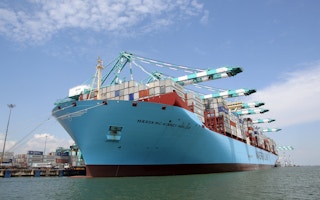Maersk Line announced on Sunday the arrival of the world’s largest container ship, and first ever Triple-E vessel, at the Port of Tanjung Pelepas in Malaysia.
To continue reading, subscribe to Eco‑Business.
There's something for everyone. We offer a range of subscription plans.
- Access our stories and receive our Insights Weekly newsletter with the free EB Member plan.
- Unlock unlimited access to our content and archive with EB Circle.
- Publish your content with EB Premium.
Called the Maersk Mc-Kinney Moller, the Triple-E cargo ship embarked on its maiden voyage, marking a new era in shipping as the most eco-friendly ship. Triple-E stands for economy of scale, energy efficiency and environmentally improved.
According to Maersk Line, part of the Danish oil and gas and shipping conglomerate A.P. Moller-Maersk Group, their company handles a sizable percentage of the world’s ocean freight, and to reduce their carbon footprint they embarked in building this monumental mode of transport.
Maersk Mc-Kinney Moller, the first Triple-E of 20 such cargo ships to be deployed for the Asia-Europe trade, measures 400 meters long, 59 meters wide and 73 metres high. It has a capacity of 18,000 twenty-foot containers (TEU) or 16 per cent more than Maersk’s standard E-class vessels.
Built by Daewoo Shipbuilding and Marine Engineering (DSME) in South Korea, the gigantic ship “is no gas-guzzling monster,” said the shipping firm. The increased capacity, which lies in the ship’s inside cavity, enables them to be energy efficient, shipping a greater quantity of containers at a lesser amount of power.
Bjarne Foldager, Maersk Line’s country manager for Malaysia, Singapore and Brunei, explained: “Besides providing economies of scale due to its size, the Triple-E vessel is also the most energy-efficient ship in the world. Its innovative design and technological features will help reduce its carbon dioxide emissions by more than 50 per cent for every container it moves, compared to the industry average on the Asia-Europe trade.”
The Triple-E includes a state-of-the-art waste heat recovery system that reduces fuel consumption. The system captures heat and pressure contained in the exhaust gas and utilises this to power the turbines, “creating mechanical energy to operate an electrical generator,” said the firm. Ordinarily, they added, the energy is simply wasted when the heat is released back into the atmosphere. This waste-to-energy system makes the ship more sustainable.
Another improvement in the ship’s design and environmental impact is in the two-propeller system. At first, the heft of the Triple-E slowed the speed of the ship, which consequently affected the type of propeller to be used. However, the ship’s designers found a solution in the twin-skeg system or using two propellers instead of one, allowing greater pushing power with less resistance in water. This means there are longer strokes with slower revolutions resulting to a top speed that is two knots less than the E-class yet more energy efficient, from an 80 MW power requirement to only 60 megawatts, shared Maersk Line.
On top off the operations, the Triple-E will also promote a longer ship life cycle through the reuse and recycling of ship parts and materials. The ship will implement a new ‘Cradle-to-Cradle Passport’ programme or a comprehensive documentation system so the company can monitor which components can be recycled or reused in the construction of a ship.
Maersk Line acknowledged that the steel used to build ships is a finite resource, and having a database to document parts and materials throughout a ship’s life will be helpful in maximising these resources.
Currently, the eco-friendly cargo vessel is set to sail for Europe. Malaysia is the ship’s final maiden call in Asia before heading to Europe via the Suez Canal, said the firm.
The Asia-Europe route, they disclosed, is tantamount to one quarter of the Maersk Line’s multi-billion dollar business. They said, “This is the largest container trade route in the world and will remain so for the foreseeable future.”
For Maersk Line, the Maersk Mc-Kinney Moller is the start of achieving their impossible mission, that of moving more goods around the world while lessening their impact on the environment.








